CARBINOXAMINE - ORAL
PHONETIC PRONUNCIATION: (kar-bi-NOX-a-meen)
COMMON BRAND NAME(S): Histex PD, Palgic
GENERIC NAME(S): carbinoxamine maleate
Uses
USES: Carbinoxamine is an antihistamine used to relieve symptoms of allergy, hay fever, and the common cold. These symptoms include rash, watery eyes, itchy eyes/nose/throat/skin, cough, runny nose, and sneezing. This medication works by blocking a certain natural substance (histamine) that your body makes during an allergic reaction. By blocking another natural substance made by your body (acetylcholine), it helps dry up some body fluids to relieve symptoms such as watery eyes and runny nose. Cough-and-cold products have not been shown to be safe or effective in children younger than 6 years. Therefore, do not use this product to treat cold symptoms in children younger than 6 years unless specifically directed by the doctor. Some products (such as long-acting tablets/capsules) are not recommended for use in children younger than 12 years. Ask your doctor or pharmacist for more details about using your product safely. These products do not cure or shorten the length of the common cold and may cause serious side effects. To decrease the risk for serious side effects, carefully follow all dosage directions. Do not use this product to make a child sleepy. Do not give other cough-and-cold medication that might contain the same or similar ingredients (see also Drug Interactions section). Ask the doctor or pharmacist about other ways to relieve cough and cold symptoms (such as drinking enough fluids, using a humidifier or saline nose drops/spray).
How to use CARBINOXAMINE - ORAL
HOW TO USE: Take the tablet, capsule, or liquid form by mouth with or without food or as directed by your doctor. This medication may be taken with food or milk if stomach upset occurs. If you are using sustained-release tablets or capsules, swallow the medication whole. Do not crush, chew, or break the tablets or capsules. Doing so can destroy the long action of the drug and may increase side effects. If you are using the liquid form, use a medication measuring device to carefully measure the prescribed dose. Do not use a household spoon. If your liquid form is a suspension, shake the bottle well before each dose. Your dosage is based on your age, medical condition, and response to therapy. Do not increase your dose or take this medication more often without your doctor's approval. Take this medication regularly in order to get the most benefit from it. To help you remember, take it at the same time(s) each day. Inform your doctor if your condition persists or worsens.
Side Effects
Precautions
Interactions
Overdose
Images
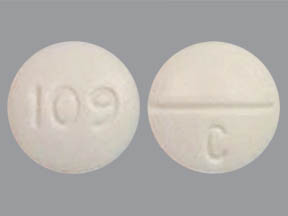
- color
- white
- shape
- round
- imprint
- 109, C

- color
- white
- shape
- round
- imprint
- B P, 605
Reviews
Faq for CARBINOXAMINE - ORAL
Carbinoxamine is an antihistamine medication that is used to relieve symptoms of allergies such as sneezing, itching, watery eyes, and runny nose.
Carbinoxamine works by blocking the action of histamine, a substance in the body that causes allergic symptoms. By blocking histamine, Carbinoxamine helps to reduce symptoms of allergies.
Common side effects of Carbinoxamine may include drowsiness, dizziness, dry mouth, blurred vision, constipation, and difficulty urinating. It is important to consult a healthcare professional if these side effects become severe or persist.
Carbinoxamine is not typically used to treat cold symptoms as it is primarily indicated for relieving allergy symptoms. However, your healthcare provider may recommend it for specific symptoms if they believe it would be beneficial.
It is essential to inform your healthcare provider about all the medications you are currently taking to avoid potential drug interactions. Some drugs, such as sedatives or tranquilizers, can increase the risk of side effects when taken with Carbinoxamine. Always consult your healthcare professional before starting or stopping any medication.
It is important to discuss the use of Carbinoxamine with a healthcare provider if you are pregnant or breastfeeding. They can assess the potential risks and benefits and provide appropriate recommendations.
Carbinoxamine should be taken as directed by a healthcare professional. It is usually taken orally with or without food. Follow the dosing instructions provided by your healthcare provider or on the medication label.
Yes, drowsiness is a common side effect of Carbinoxamine. It is important to avoid driving, operating heavy machinery, or performing tasks that require alertness until you know how the medication affects you.
The onset of action for Carbinoxamine varies among individuals. Some people may experience relief from allergy symptoms within 30 minutes, while others may take longer. It is important to follow the instructions provided by your healthcare provider.
Disclaimer
IMPORTANT: HOW TO USE THIS INFORMATION: This is a summary and does NOT have all possible information about this product. This information does not assure that this product is safe, effective, or appropriate for you. This information is not individual medical advice and does not substitute for the advice of your health care professional. Always ask your health care professional for complete information about this product and your specific health needs.
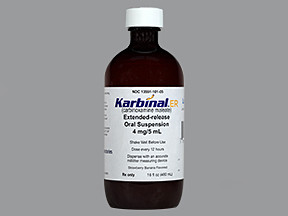

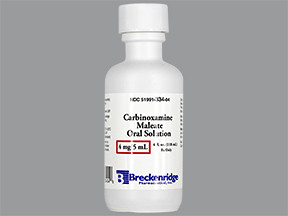
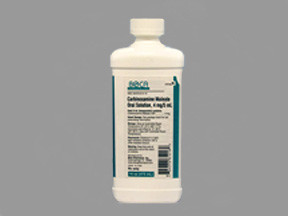
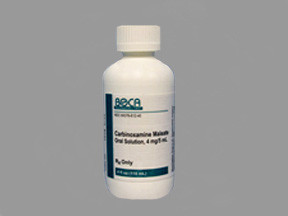
No Reviews Yet